
A view of the Naknek River through the trees; although a serene scene from above the ice, there is endless activity below. (Photo by K. Davis)
I approach the partially frozen river, which, at first glance appears to be just an unimpressive assortment of ice slabs, strewn about like leftover cocktail glasses on New Year’s Eve. The crystal cacophony continues as I am gazing in all directions at this seemingly mediocre party scene, trying to recall if there was any ice at all this time last year. After hearing another chandelier fall from the ceiling I decide to stop pouting and embrace what I already know. Mother nature doesn’t give a lick about your demand for rainbows and butterflies, much less your whiny request for suitable shorts-wearing weather.
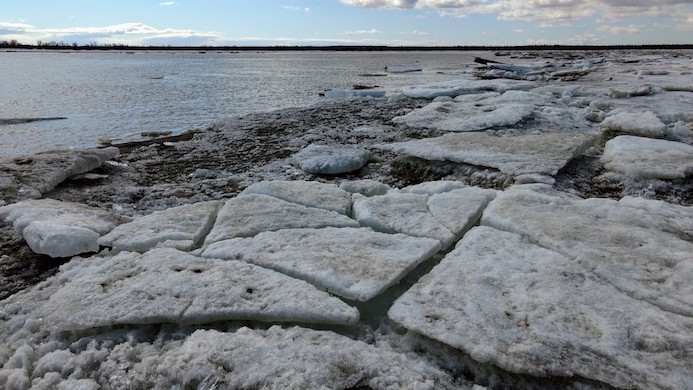 Frosted debris strewn about displays a scene of sluggish, yet deliberate thaw and freeze; winter is succumbing to spring. (Photo by K. Davis)
Frosted debris strewn about displays a scene of sluggish, yet deliberate thaw and freeze; winter is succumbing to spring. (Photo by K. Davis)I begin walking on top of the wintery shambles, hoping to isolate an instrument of the celebratory glass orchestration. I discover what appears to be Edward’s scissor hand in frozen water form and begin to realize, once again, that I have underestimated mother earth’s ability to delight herself with the world’s rarest displays of art.
Humbled, I continue to curate the icy exhibition, finding one spectacular formation after another. Each piece is unique, having suffered a different scouring than the rest in the struggle of winter succumbing to spring. There are spires and arches, potholes and peaks, fractures and keyholes, all exceptionally displaying the sluggish, yet deliberate process of thaw and freeze. It is Edward’s extremities that I find to be the most interesting, and most subject to the spring sun’s embrace. As I squat down, I am mesmerized by the slanted pinnacles as they slowly surrender to the heat and gravity, shattering upon the frozen floor, flinging shards of diamonds around my feet. My feet. I wanted to stand in the river, to let the spring water flush the winter out, making room for summer. I ditch my sandals and instead, let this freezing landscape polish my tender soles. I feel winter melting away below my toes and I am delighted, but I only last a minute before my feet are numb and Edward loses yet another hand.
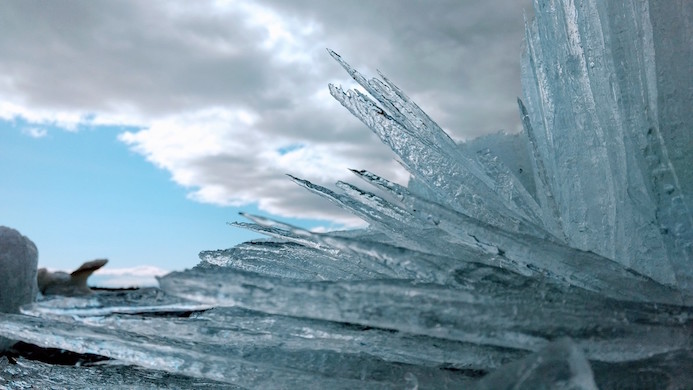
Edward’s scissor hand,’ a structure of spikes formed slowly by the release of trapped air from hundreds of columns no more than a millimeter in diameter. (Photo by K. Davis)
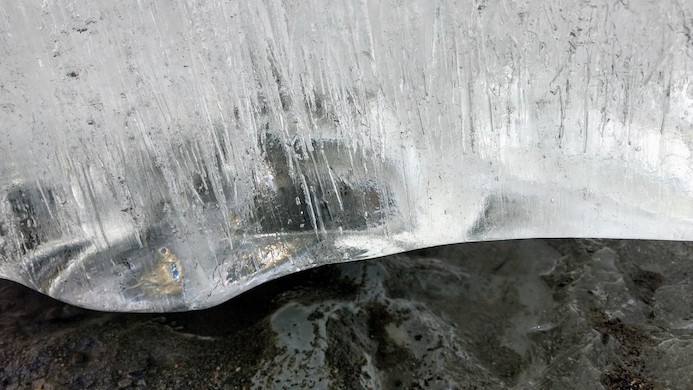 A block of ice displaying the glossy columns of trapped air, prior to their submission to the sun. (Photo by K. Davis)
A block of ice displaying the glossy columns of trapped air, prior to their submission to the sun. (Photo by K. Davis)I continue meandering through the broken glass, stopping briefly to play on a translucent seesaw that seems to be unyielding to the sweet persuasions of spring. However, upon inspection from below, it seems no relic from this winter wonderland can escape. The slow, methodical drip from a stubborn corner sings its dripping song of submission into a small pool of others defeated; a pool full of grasses, snails and macroinvertebrates.
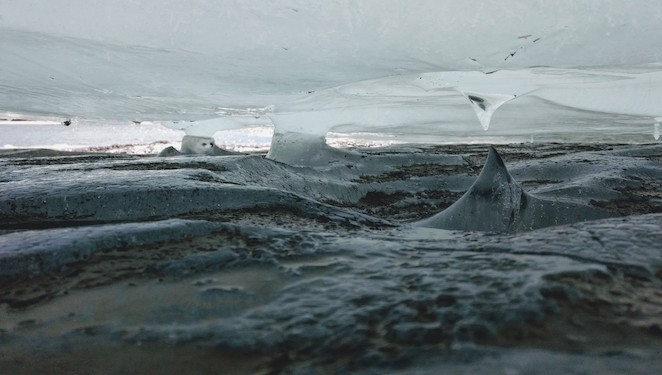 With features resembling a cave, the underside of this block of slowly changing ice is littered with potholes; pint-sized petri dishes full of microscopic life. (Photo by K. Davis)
With features resembling a cave, the underside of this block of slowly changing ice is littered with potholes; pint-sized petri dishes full of microscopic life. (Photo by K. Davis)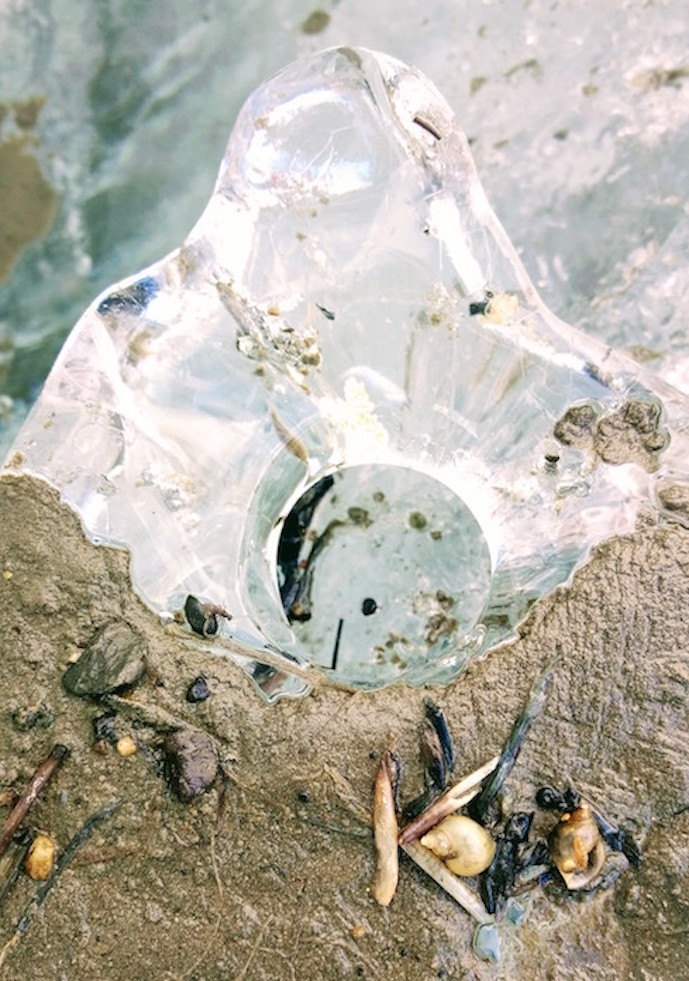 Tiny organisms and invertebrates can become trapped as the river ebbs and flows, providing ample opportunities for foraging by waterfowl and shorebirds. (Photo by K. Davis)
Tiny organisms and invertebrates can become trapped as the river ebbs and flows, providing ample opportunities for foraging by waterfowl and shorebirds. (Photo by K. Davis)These signs of life are proof that this subdued season is in fact coming to an end, and a reminder of the many complex ecosystems found here on the Alaska Peninsula that rely heavily on this cycle of freeze and thaw. Frozen rivers and low flows provide opportunity for caribou migration, refuge for waterfowl and a buffet of food options for beluga whales, like rainbow smelt, when they make the journey inland from surrounding bays. Sockeye salmon, one of Katmai’s keystone species, require the icy insulation for their eggs to survive winter and develop properly into tiny fry. Only the strongest will eventually travel to the sea to fully mature before returning years later to spawn, bringing back with them nutrients from the ocean to continue sustaining the health and well-being of these resilient, yet fragile watersheds.
 Sufficiently thin sheets of ice allow sunlight to pass through while sheltering the underside from wintery elements, providing an environment for algal and bacterial colonies which in turn, support the river’s benthic communities. (Photo by W. Artz)
Sufficiently thin sheets of ice allow sunlight to pass through while sheltering the underside from wintery elements, providing an environment for algal and bacterial colonies which in turn, support the river’s benthic communities. (Photo by W. Artz)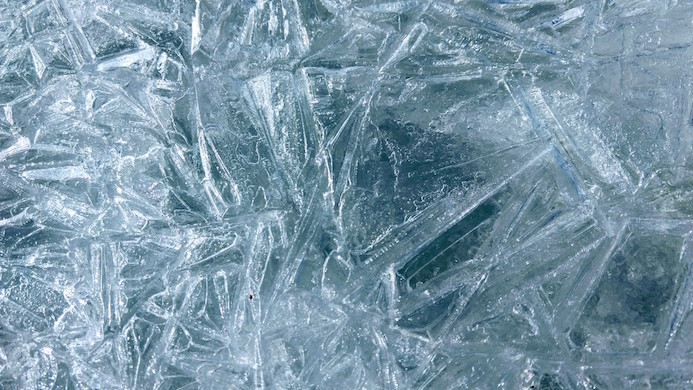
Paired with low water flows, thin ice can act as an incubator for sockeye salmon eggs and alevin, providing them insulation from sub-zero air temperatures and protection from predators that are active throughout the winter. (Photo by K. Davis)
As I am pondering these ecological processes, and feeling gratitude for the opportunity to once again bear witness to such powerful life cycles, I stumble upon a frozen form that very much resembles a champagne flute. I raise it to the sunlit spring sky feeling confident that the 2017 summer season at Katmai National Park and Preserve will be a rich one; full of life, death, mystery and familiarity, and maybe a few rainbows and butterflies.
Feeling satisfied, I throw my champagne flute on the sparkling ballroom floor and depart the riverside scene feeling like an affluent princess in a fairyland whose adventure has only just begun. Maybe mother nature does give a lick about what we want after all.
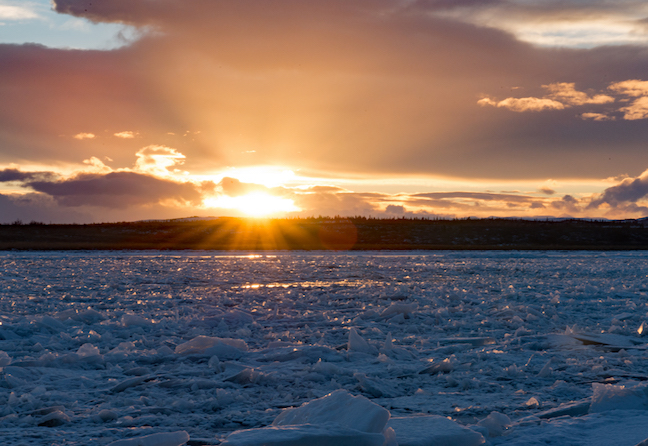 Ice formations blanket the Nakek river, each playing a vital role in the beautifully complex struggle for life on the Alaska Peninsula. (Photo by W. Artz)
Ice formations blanket the Nakek river, each playing a vital role in the beautifully complex struggle for life on the Alaska Peninsula. (Photo by W. Artz)